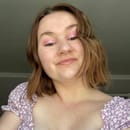I remember when I came out to myself. I was relatively young, 13 years old. I figured it out when I realized that I was infatuated with every single girl on Glee and was convinced that I would grow up to be as cool as Emily Fields from Pretty Little Liars. I wasn’t necessarily concerned with this revelation; I just brushed it off and figured I would sort it out eventually.
But what I was grappling with was my gender presentation and how valid I felt in it as a lesbian. If you know me, you know I am the epitome of the outdated definition of a “hyperfeminine” girl. My favourite colour is pink, I collect makeup, and one of my favourite hobbies is online shopping and watching old musicals. When I play Mario Kart, I play as Toadette, THAT’S how girly I am. While this is all fine and good now, 13-year-old me was STRESSED because I must either a) be lying to myself about liking these girly things or b) not really be gay.
As I continued to grow up, it became clearer that I was *definitely* gay (iykyk). As I started to come out to my friends, I was met with acceptance, but admittedly, they “didn’t see it coming” because of my style and demeanour. My teenage mind convinced me that I was living a lie, so to live my “truth,” my style did a complete 180. I started wearing baggier ripped jeans, beanies, and flannels in every colour. Any clothing item that is stereotypically linked to lesbianism, I wore it. I started doing some of my shopping in the men’s section and scoffed at the idea of wearing dresses.
While this style was admittedly super comfortable and looks amazing on so many people, I didn’t feel like me. I missed my fun patterned pants and glitter eyeshadow. I felt like I was dressing to please society’s definition of what a gay woman looks like, and frankly, I wanted girls to like me and know I was queer.
Eventually, I decided that I needed to revert to my true sense of style, and while I loved it, sending out “queer signals” was super difficult. I recognize that I have the privilege of “looking straight,” so I am far less likely to experience homophobic threats, and for that, I am thankful, but it is a double-edged sword. I got very used to not being believed.
Tinder was a minefield of dead-end conversations that always ended in the same thing. I found myself hearing the same set of phrases over and over: “You can’t really be gay, you are so girly,” This is just a phase for you,” and the most dreaded, “Oh honey, you must just be experimenting.”
It was super frustrating. Invalidating someone is never good, but it sucked having to convince people that I was supposed to relate to that I was one of them. I have never been interested in men, and all of my romantic and sexual encounters have been with women, yet, I was still begging to be taken seriously.
I was 19 when I heard the term “lipstick lesbian” for the first time. For those who don’t know, according to Google, a lipstick lesbian defined as, “slang for a lesbian who exhibits a greater amount of feminine gender attributes, such as wearing makeup, dresses or skirts, and having other characteristics associated with feminine women.” I was worried that it was meant to be derogatory, but I later learned that it is interchangeable with the term “femme.”
After learning about this, I did some research and felt much better. I found femme lesbian content creators, artists, writers and couples. Women who beat their face daily, have gorgeous long hair, eyelash extensions, and more, but were so open with their sexual orientations. I saw myself.
These women all have different experiences, from growing up as a cheerleader, to being in the choir at their church to having multiple boyfriends before coming to terms with their sexuality. There is a common phenomenon of “gay being a phase” that was prevalent in all of their worlds because they didn’t look the part, or fit what most people think lesbianism is, which is believed to be inherently masculine (even though they are literally two women or non-binary people together and does not involve a man at all –– but do not get me started).
As the years passed, people have become more open-minded about what “gay” looks like. There is less of a stereotype of queer women being manly or dressing like a lumberjack. In fact, it is often hard to tell what people’s sexualities are without asking them. I have caught myself searching for hints or clues to infer someone’s sexuality, but I have learned that it is better not to assume at all.
So now, in my early 20s, I still need to come out almost daily, and I still get the occasional comment about “looking straight.” Despite this, I am a confident queer woman wearing a pink outfit, sporting a rainbow flag tattoo on my ribcage, and writing this article wearing long, fake nails. And that does not make me any less gay.


